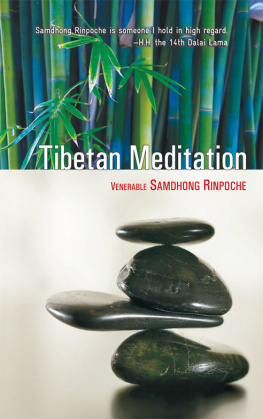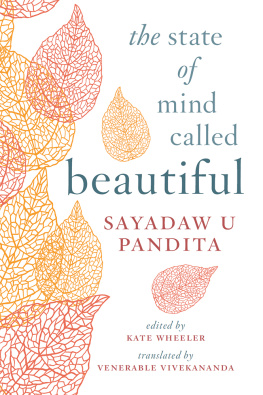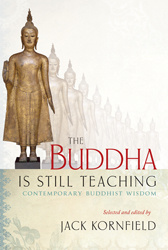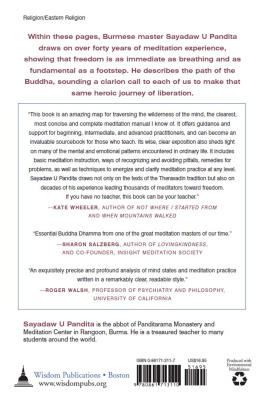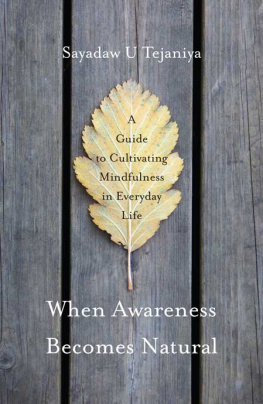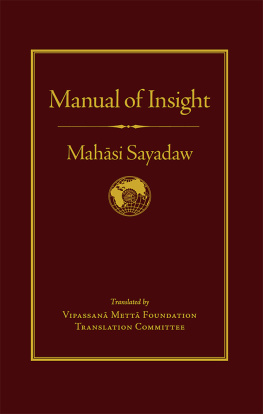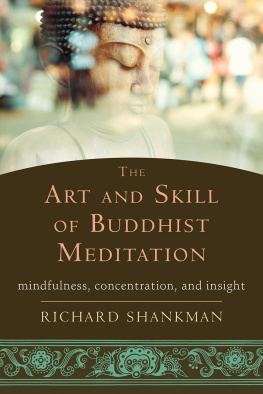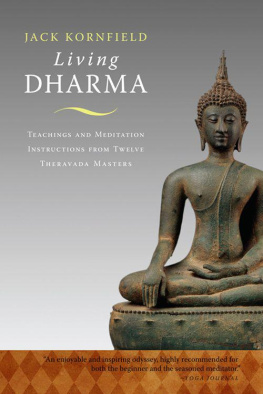Venerable Mahasi Sayadaw - Practical Insight Meditation
Here you can read online Venerable Mahasi Sayadaw - Practical Insight Meditation full text of the book (entire story) in english for free. Download pdf and epub, get meaning, cover and reviews about this ebook. year: 1944, publisher: Association for Insight Meditation, genre: Religion. Description of the work, (preface) as well as reviews are available. Best literature library LitArk.com created for fans of good reading and offers a wide selection of genres:
Romance novel
Science fiction
Adventure
Detective
Science
History
Home and family
Prose
Art
Politics
Computer
Non-fiction
Religion
Business
Children
Humor
Choose a favorite category and find really read worthwhile books. Enjoy immersion in the world of imagination, feel the emotions of the characters or learn something new for yourself, make an fascinating discovery.
- Book:Practical Insight Meditation
- Author:
- Publisher:Association for Insight Meditation
- Genre:
- Year:1944
- Rating:5 / 5
- Favourites:Add to favourites
- Your mark:
- 100
- 1
- 2
- 3
- 4
- 5
Practical Insight Meditation: summary, description and annotation
We offer to read an annotation, description, summary or preface (depends on what the author of the book "Practical Insight Meditation" wrote himself). If you haven't found the necessary information about the book — write in the comments, we will try to find it.
Practical Insight Meditation — read online for free the complete book (whole text) full work
Below is the text of the book, divided by pages. System saving the place of the last page read, allows you to conveniently read the book "Practical Insight Meditation" online for free, without having to search again every time where you left off. Put a bookmark, and you can go to the page where you finished reading at any time.
Font size:
Interval:
Bookmark:

Practical Insight Meditation
Authors Preface
It is a truism to say that nobody likes suffering and everybody seeks happiness. In this world of ours, human beings are making all possible efforts for prevention and alleviation of suffering, and enjoyment of happiness. Nevertheless, their efforts are mainly directed towards physical well-being by material means. Happiness is, after all, conditioned by attitudes of mind, and yet only a few persons give real thought to mental development, fewer still practice mind training in earnest.
To illustrate this point, attention may be drawn to the commonplace habits of cleaning and tidying up ones body, the endless pursuits of food, clothing, and shelter, and the tremendous technological progress achieved for raising the material standard of living, for improving the means of transport and communications, and for prevention and cure of diseases and ailments. All these efforts are, in the main, concerned with the care and nourishment of the body. It must be recognized that they are essential. However, these human efforts and achievements cannot possibly bring about the alleviation or eradication of suffering associated with old age and disease, domestic infelicity and economic troubles, in short, with non-satisfaction of wants and desires. Sufferings of this nature are not overcome by material means; they can be overcome only by mind training and mental development.
Then, it becomes clear that the right way must be sought for training, stabilizing and purifying the mind. This way is found in the Mahsatipahna Sutta, a well-known discourse of the Buddha, delivered well over 2,500 years ago. The Buddha declared thus:
This is the sole way for the purification of beings, for the overcoming of sorrow and lamentation, for the destroying of pain and grief, for reaching the right path, for the realisation of nibbna, namely the four foundations of mindfulness.
The four foundations of mindfulness are 1) the contemplation of the body, 2) the contemplation of feelings, 3) the contemplation of mind, and 4) the contemplation of mind objects.
Obviously, this way should be followed by those in search of happiness, with a view to getting rid of the impurities of mind, which are the cause of their sufferings.
If one were asked whether he wished to overcome sorrow and lamentation, he would surely say, Yes. Then he, nay everybody, should practise the four foundations of mindfulness.
If one were asked whether he wishes to destroy pain and grief, he would not hesitate to reply in the affirmative. Then he, nay everybody, should practise the four foundations of mindfulness.
If one were asked whether he wishes to reach the right path and realise nibbna, the state of being absolutely free from old age, decay and death and from all sufferings, he would certainly give an affirmative answer. Then he, nay everybody, should practise the four foundations of mindfulness.
How shall one practise the four foundations of mindfulness? In the Mah Satipahna Sutta, the Buddha said, Dwell practising body contemplation, feeling contemplation, mind contemplation and mind-objects contemplation. Without the guidance of a well-qualified teacher, however, it will not be easy for an average person to practise these contemplations in a systematic manner in order to make progress towards development of concentration and insight.
Having myself undergone a most intensive practical course of Satipahna meditation under the personal guidance of the Most Venerable Mingun Jetavan Saydaw of Thaton, I have imparted the technique of meditation ever since 1938 and given personal instruction, as well as through books and lectures, to several thousands of yogis. In compliance with the requests of those of the earlier batches, who had benefited from my personal instructions, I wrote a treatise on vipassan or insight meditation, in two volumes. The treatise was completed in the year 1944 and has been published in seven editions. In all the chapters, except in Chapter V, dissertations and discussions are made with reference to Pi texts, commentaries and sub-commentaries. In Chapter V, I chose to write in common language for easy understanding by my pupils as to how they should begin and then proceed step by step, stating fully the salient features, in line with the Visuddhimagga and some other texts.
This present book is the English translation of the said Chapter V. The first fourteen pages of the Burmese original were translated into English in 1954 by U Pe Thin, an old pupil of mine, for the benefit of those who came from abroad to our Meditation Centre. Pages 15 to 51 of the Burmese original were translated into English, in compliance with the wish of the Venerable Nyanaponika Mahthera, by Myanaung U Tin, a disciple and dayaka of mine. Incidentally, it may be mentioned that the area of our Meditation Centre, Ssana Yeiktha, is nearly twenty-four acres, with over fifty buildings to house the meditation teachers and yogis, monks as well as lay, both men and women.
The Venerable Nyanaponika Mahthera put this translation into final literary shape after obtaining confirmation of his valuable suggestions. U Pe Thins translation was revised by and improved upon, as to style, by Miss Mary McCollum, an American Buddhist lady. She practised Satipahna meditation under the guidance of Anagarika Munindra at the Burmese Vihra, Bodh-Gaya, Bihar, India. Anagarika Munindra stayed with us for a considerable period. He sent her revision to us for perusal and approval. When done, it was forwarded to the Venerable Nyanaponika Mahthera. This book is, therefore, the coordination and combined publications of the aforesaid two translations, with my preface added thereto.
Chapter V of my Burmese treatise, as mentioned earlier, was written in common linguistic style. I should like to say here that the doctrinal terms found in this book without Pali names are fully explained in Progress of Insight, translated from my Pali treatise into English by the Venerable Nyanaponika Mahthera. His book, The Heart of Buddhist Meditation, is itself a veritable mine of information and instruction on this subject of vital importance.
In conclusion, I would like to say that I deeply appreciate the services of those who have done the translations and revisions as well as of those who are responsible for the publication of this book, secondly to urge the readers of this book not to be content with the theoretical knowledge contained therein but to apply that knowledge to systematic and sustained practice, and thirdly to express my earnest wish that they gain insight soon and enjoy all the benefits vouchsafed by the Buddha in the preamble of the Mah Satipahna Sutta.
Bhaddanta Sobhana (Agga Mahpaita)
Mahsi Saydaw
October 1st, 1970
Ssana Yeikth,
16, Hermitage Road,
Rangoon, Burma
Preparatory Stage
If you sincerely desire to develop contemplation and attain insight in this your present life, you must give up worldly thoughts and actions during the training. This course of action is for the purification of conduct, the essential preliminary step towards the proper development of contemplation. You must also observe the rules of discipline prescribed for laymen, (or for monks, as the case may be) for they are important in gaining insight. For laity, these rules comprise the eight precepts which Buddhist devotees observe on Sabbath days (Uposatha) and during periods of meditation. An additional rule is not to speak with contempt, in jest, or with malice to or about any of the noble ones who have attained states of sanctity. If you have done so, then personally apologize to him or her or make an apology through your meditation instructor. If in the past you have spoken contemptuously to a noble one who is at present unavailable or deceased, confess this offence to your meditation instructor or introspectively to yourself.
Font size:
Interval:
Bookmark:
Similar books «Practical Insight Meditation»
Look at similar books to Practical Insight Meditation. We have selected literature similar in name and meaning in the hope of providing readers with more options to find new, interesting, not yet read works.
Discussion, reviews of the book Practical Insight Meditation and just readers' own opinions. Leave your comments, write what you think about the work, its meaning or the main characters. Specify what exactly you liked and what you didn't like, and why you think so.


